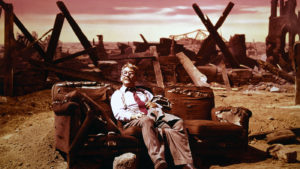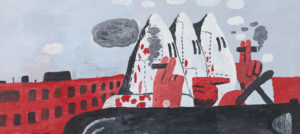Among the most ingenious moments in Kraftwerk’s admirable oeuvre is the point in 1981’s “Pocket Calculator” when a human voice self-contentedly sings: “By pressing down a special key / It plays a little melody.” The melody follows in confirmation. The genius here seems to lie in the blunt honesty of the singer, owning up to the contemporary condition of music as an art form that has largely been outsourced to machines. It’s not that the German electronic band invented the technology, nor that they were the first to make use of it. They are simply among the first to figure out how to elevate it to self-awareness, and to press it into a gesture of timely irony and potentially timeless beauty; that is, to make art out of it.
The little melody in question is of course a pre-set. Its sequence of notes is planned in advance, and once the key is pressed, the machine may be relied upon to do only the thing it has been programmed to do. The melody, it goes without saying, is no Bach fugue. It is simple, naïve, kind of dumb; and within the context of the song, it is utterly compelling.
Several conditions — technological, cultural, historical — had to fall into place in order for this melodic interlude, with its verbal introduction, to come across to the critical listener as an expression of genius. All of these conditions might be cited in response to any philistine tempted to declare, of the pressing down of that special key, that “I could have done that too”. We are used to hearing such petulant ressentiment, especially in connection with the 20th-century avant-garde in the figurative arts: “I could have entered a urinal in an exhibition, too”; “I could have painted an all-white monochrome, too”; etc. The simplest response is, “Yes, but you didn’t”.
But this is probably too succinct to teach the philistine anything new about how art works. It is going to be particularly important to sensitise people to the logic and dynamics of artistic creation as we enter the new era of AI-generated artworks and are bombarded with new images created by machines following the input of a mere verbal prompt from a human being: DALL·E 2 being a prime example. Among other unpleasant prospects this new technology opens up, we will have to brace ourselves for a new wave of declarations from philistines telling us of the things they could have done too. It will be useful to have something new to say to them in response.
While technical competence is unmistakable, genius has a strange way of horseshoeing with idiocy, which is why we need critics to help us tell the difference. Jimi Hendrix lighting his guitar on fire is genius; a suburban kid in 1967 attempting the same, in his parents’ garage, is idiocy. Context matters, and by 1967 Hendrix was almost uniquely positioned to change the world, at least a little bit, with a gesture that would have been merely wasteful if attempted by nearly any other human alive.
Catchphrases that we associate with a particular artist or character are almost always banal in the extreme, but when Jimmy Durante says “Ha-cha-cha-cha” or Jimmie Walker says “Dyn-o-mite!”, we are witnessing a gesture of something like genius as well, or at least of idiosyncrasy, which is akin to genius in that it flows from an individual’s unique ingenium or natural aptitude, and proves to be mostly unteachable and entirely untransferable. I can of course go around evoking “dynamite” whenever I am enthused about something, but it will come across as perplexing at best and pathetically imitative at worst. When Jimmie Walker said it by contrast, he became himself a flash of light, a rupture in our ordinary expectations of the world. I’m a critic and I’m here to tell you that that’s genius.
Wit, too, like idiosyncrasy, is a species of the genus of genius. Once Winston Churchill sat at a formal dinner, dissatisfied with the food and the service. When the champagne arrived, he is reported to have remarked: “Finally, something warm.” I could try out that same phrase in a million different settings, and perhaps one or two of these would find it landing as wit; in the vast majority of cases it would be a simple non-sequitur, in a few it would be an accurate, literal, and unfunny description of the thing or event before me. With another million attempts, perhaps an occasion would arise in which the line approached the quality it had in Churchill’s mouth. Genius, along with its lesser cousins, I mean, is a fluid and variable thing. But one thing it definitely is not is technical competence.
Philistines go in for photorealist painting; they imagine it testifies to “progress” in representation since the time of the Dutch Masters, since its lines are sharper, its objects come across on the canvas as more like objects the way we find them in “the real world” (that is, the world mediated by the physics of light and by the physiology of vision, which ordinarily we scarcely understand, or even think about, instead taking the affordances of our sense of sight to be straightforward reports of external reality itself). But of course what photorealist paintings actually resemble are photographs, and in this respect to learn to paint the world photorealistically is to create machine-aided paintings, where the machine is, namely, the camera. If David Hockney is correct, cameras of a sort, camerae obscurae, have been deployed since the Renaissance to assist in capturing the world on canvas. We have had machine-aided visual art for a very long time, but the use of machines in one’s artistic labours has never been necessary or sufficient for the creation of works of lasting aesthetic merit.
Could that be about to change? It’s 2022 and there’s a new thing going around on Twitter. You can click on a link, and arrive at a site that invites you to upload a photo of yourself, after which you will get a “reverse AI portrait” that spells out, in language, what it is the computer is “seeing”. I give it a try, and this is what it tells me: “A man with blonde hair and a black shirt, a character portrait, inspired by Eric Peterson, reddit contest winner, precisionism, doing the bateman stare, taken in the early 2020s, photograph of Christopher Walken, Thom Wasselmann, without glasses, John Waters, face with artgram.”
I’m not impressed. It strikes me that the machine is just looking for something, anything, to say. It’s smart enough to know that many people get excited when they hear mention, any mention, of Christopher Walken; they launch into bad imitations and everyone loves it. Bring up his name along with some other nonsense phrases and some bare factual descriptions of my physiognomy, and you’re sure to get a few retweets. This little fragment of language is optimised for virality, not for saying anything true. It is just more social-media bullshit; it is not art.
It’s 2030, after the war, and I’m at an AI art fair in Vladivostok. There’s some guy, some hot new artist on the scene, who makes customised portraits of visitors based on a special sequence of keywords that he enters in secret, on the basis of his spontaneous reading of our physical, behavioural and apparent moral qualities. I wait in line impatiently, and when my turn comes and my portrait finally uploads to my retinal “screens”, I am confronted with an image of myself that appears somehow warped, perverse, somewhat beastly, and yet, I have to admit, also, profoundly familiar and true. I don’t know how the artist and his machine managed to pull it off. I’m impressed. The dude got me.
Kraftwerk’s special key, as a pre-set, could only do one thing, and cameras too, have generally been limited to registering what is in front of their lens in accordance with the mechanical parameters, exposure time and so on, set in advance by the photographer. One genuinely novel feature of AI art is that it is not like this. Two different users can enter the same prompts into the same programme at different moments, and will get two different images in response. This places the human-machine collaborative work of creation somewhat closer to the activity of the Turkish fortune-teller who compels a rabbit to sniff out one of several possible pieces of folded paper that contains, in writing, a hint of the customer’s future. A good niyetçi will know how to manipulate his rabbit to give interesting results, even if the choice of paper depends in the end on the rabbit’s own inscrutable perception of the world.
Divination is not ordinarily considered art, though it is acknowledged to rely on artifice, and though much art incorporates aleatoric principles that share quite a bit with the work of the tea-leaf reader or the caster of knucklebones. The particular arrangement of tea leaves is generally taken to be informative, at least in a make-believe way, rather than aesthetic, but the boundary here shifts easily, and indeed we might see the category of the aesthetic as a special variety of informativeness, where the patterns or representations we see tell us something, even if we cannot say precisely what that is.
AI art will supervene, is already supervening, upon several different categories of human endeavour — the clever technology-dependent stunt, the joke, divination — and will continue to please us and disappoint us in just the same way that these other endeavours do. It is simply not a meaningful question to ask whether any AI output may appropriately be categorised as art. Art is artifice plus, one hopes, a hint of genius, or something close to that. Such hints can shine through, as I’ve attempted to remind you, in the most unlikely, indeed the silliest places. There is of course no reason why AI should not also be such a place.
Whether we enshrine AI art within our society, giving it a place in art fairs, giving out prizes for it, and so on, is entirely up to us. There is nothing about the technology in itself that can guide us in determining whether we “should” do this or not. Art is what we value, what we attend to, and deem worthy of aspiration to excellence; this is why some activities come forward as art in some cultures, but not in others — the tea ceremony is art in Japan, but if I hastily serve you a mug of Lipton, I am not giving you a poor contribution to an art-form — I’m just giving you tea.
Quite apart from the normative question of whether AI output should be considered art under some circumstances — a question that is unanswerable — I am confident in predicting that we will have AI art. In this art there will be occasional flashes of genius, or something like it, against a general background of cultural overproduction of shit. This has also been the general balance throughout the history of photography, television, and cinema. The most significant change with the rise of AI comes with the human relinquishing of control over the pre-set parameters.
But this does not so much move us into uncharted territory, as it simply assimilates AI art to other forms of human creativity, such as divination, which in the past have used objectively random processes to make their determinations, but have also often used animals. In many ways, as with an engine and its “horsepower”, we are simply finding new ways to transfer work from animals to machines, both of which are entities that are sufficiently like us to make determinations that will resemble our own choices, but sufficiently unlike us for their determinations to come across to us as “weird”, as suitable moments to say “whoah”. That “whoah” can be interpreted as an aesthetic experience, with sufficient institutional backing.
I’m not looking forward to any of this. I am going to stick with my vintage technologies, and my aesthetic orientation will remain forever backward-looking. But even less than the new era of AI art am I looking forward to the inevitable wave of renewed debate around the inane and empty question of whether this new variety of culture-embedded and technology-dependent activity ought to count as art. It’s like asking whether a hamburger can count as breakfast. There is no ontological rift between breakfast and lunch; breakfast is what we say it is, and if you feel like your 8am burger is not doing it for you, this tells you something only about your expectations, and not about the world.
There is similarly no ontological divide separating artworks from “the commonplace”. Art tends to emerge at the sites of social value, of care. If we think AI art is a bad idea, then we might slow its ascendancy by grounding our care in other spheres of human life than those shaped by cutting-edge technologies. But this is almost certainly not going to happen.
Disclaimer
Some of the posts we share are controversial and we do not necessarily agree with them in the whole extend. Sometimes we agree with the content or part of it but we do not agree with the narration or language. Nevertheless we find them somehow interesting, valuable and/or informative or we share them, because we strongly believe in freedom of speech, free press and journalism. We strongly encourage you to have a critical approach to all the content, do your own research and analysis to build your own opinion.
We would be glad to have your feedback.
Source: UnHerd Read the original article here: https://unherd.com/





